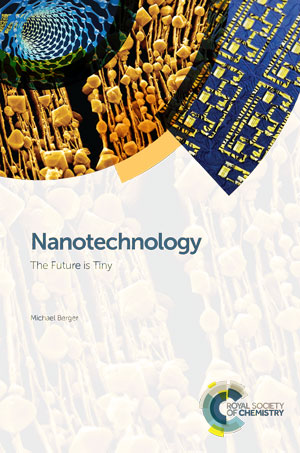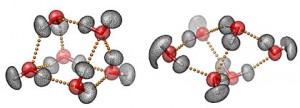The book has a pretty cover (carbon nanotubes in the left corner, nanoparticles? next, and a circuit board to complete the image),
The book, written by Michael Berger, publisher of the Nanowerk website, was announced in an Aug. 31, 2016 Nanowerk Spotlight article (Note: Links have been removed),
“Nanotechnology: The Future is Tiny” puts a spotlight on some of the scientists who are pushing the boundaries of technology and it gives examples of their work and how they are advancing knowledge one little step at a time.
Written by Nanowerk’s Michael Berger, this book is a collection of essays about researchers involved in all facets of nanotechnologies. Nanoscience and nanotechnology research are truly multidisciplinary and international efforts, covering a wide range of scientific disciplines such as medicine, materials sciences, chemistry, biology and biotechnology, physics and electronics.
Here’s more about the book before I comment on the marketing (from the Nanotechnology: The Future is Tiny webpage on the Royal Society of Chemistry’s website),
Nanotechnology: The Future is Tiny introduces 176 different research projects from around the world that are exploring the different areas of nanotechnologies. Using interviews and descriptions of the projects, the collection of essays provides a unique commentary on the current status of the field. From flexible electronics that you can wear to nanomaterials used for cancer diagnostics and therapeutics, the book gives a new perspective on the current work into developing new nanotechnologies. Each chapter delves into a specific area of nanotechnology research including graphene, energy storage, electronics, 3D printing, nanomedicine, nanorobotics as well as environmental implications.
Through the scientists’ own words, the book gives a personal perspective on how nanotechnologies are created and developed, and an exclusive look at how today’s research will create tomorrow’s products and applications. This book will appeal to anyone who has an interest in the research and future of nanotechnology.
Publication Details
Print publication date: 30 Aug 2016
Copyright: 2016
Print ISBN: 978-1-78262-526-1
PDF eISBN: 978-1-78262-887-3
EPUB eISBN: 978-1-78262-888-0
DOI:10.1039/9781782628873
According to Berger’s description of his book (from the Aug. 31, 2016 Nanowerk Spotlight article),
Some stories are more like an introduction to nanotechnology, some are about understanding current developments, and some are advanced technical discussions of leading edge research. Reading this book will shatter the monolithic term “nanotechnology” into the myriad of facets that it really is.
Berger has taken on a very challenging task for a writer. It’s very difficult to produce a book that will satisfy the range of audiences described. Appealing to a different audience in each chapter is probably the only way to approach the task. I think the book may prove especially useful for someone who’s more of a beginner or intermediate because it lets you find your level and as you grow in confidence you can approach more challenging chapters. The mystery is which chapters are for beginner/intermediates?
A rather interesting marketing strategy has been adopted, which has direct bearing on this mystery. The publisher, the Royal Society of Chemistry (RSC), has made some material available for free (sort of). There is no direct charge for the Front Matter, the Preface, the Table of Contents, or Chapter 1: Generating Energy Becomes Personal but you do need registration to access the materials. Plus, I believe they’re having a problem of some kind as the same information was accessed each time I clicked whether it was on the Front Matter, the Preface, or the Table of Contents. As for Chapter 1, you will get an abstract only.
You can purchase chapters individually or buy the hardback version of the book for £66.99 or the full ebook (EPUB) version for £200.97. Chapter 2: No More Rigid Boxes—Fully Flexible and Transparent Electronics (PDF) is available for £28.00. The pricing seems designed to encourage hardback purchases. It seems anyone who only wants one chapter is going to have guess as to whether it was written for an expert, a beginner, or someone in between.
Depending on your circumstances, taking a chance may be worth it. Based on the Nanowerk Spotlight articles, Berger writes with clarity and understanding of his subject matter. I’ve found value even in some of his more challenging pieces.

